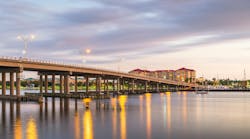Picture this: A tractor-trailer with a bumper sticker stating “Safety is Priority #1” is moving at 55 mph, head-on toward a dump truck in a roadway work zone. The dump truck has a sticker by the cab door that says, “Safety First.” Standing between the two is a construction worker who has no place to go.
That’s not a situation anyone wants to face.
But as we evaluate the safety objectives of traffic engineers and construction safety specialists, it is easy to see how their safety objectives can be just like the tractor-trailer and the dump truck. Both are big believers in safety, but unless they communicate better about their objectives—and conflicts—they are racing head-on into a collision where workers may be the victims.
Let’s look at a few examples of these different perspectives on safety.
Scenario one: A primary concern of the traffic engineer is keeping traffic moving freely and consistently through work zones to minimize congestion, traffic queues and the resulting potential for rear-end accidents that frequently occur when traffic unexpectedly slows down. The engineer seeks to promote safety by keeping speed limits at expected velocities and minimizing lane closures and roadway encroachments caused by construction, renovation, maintenance, etc., that may result in queues.
The contractor’s safety specialist seeks to have positive separation between his workers and traffic. The safety specialist wants traffic to slow down as it passes through the work zone to reduce the chances of an errant vehicle passing through the traffic control devices and striking workers.
The contractor’s safety specialist wants as much space in his work area as possible to maintain a safe distance between workers on foot and large construction equipment, because a large portion of worker deaths are caused when the employee is run over or backed over by dump trucks and other construction equipment.
Scenario two: The traffic engineer is concerned about the congestion, delays and safety hazards that result when traffic is disrupted by construction work zones during peak traffic hours. To minimize the hazards and disruptions, the engineer schedules road work to take place during evening hours when traffic volumes are lighter.
The contractor’s safety specialist avoids working during night hours because of concerns about higher rates of motorists driving under the influence of drugs and alcohol or driving while drowsy and fatigued. During evening hours it is more likely that a driver will not respond to work-zone warnings and cross the dividing line between traffic space and work space.
The contractor’s safety specialist also is worried that workers will be tired and less attentive in this hazardous work environment. The specialist must take special precautions to make sure workers can be seen by traffic and construction vehicles and that workers can clearly see potential hazards in their work environment.
These are just a few examples of the different perspectives between the safety goals of a traffic engineer and a contractor’s safety specialist. While neither is likely to concede that one safety priority is more important than the other, it is clear that both sides need to develop open lines of communication if they are to succeed in promoting safety without compromising the efforts of the other. The situation becomes even more complex when one considers the involvement of law enforcement, emergency responders, motorist assistance, intelligent transportation systems and safety features in the vehicles and equipment.
Coordinated caution
As the U.S. interstate system approaches its 50th anniversary in 2006 and with Congress and the president recently approving a six-year, $286.5 billion investment in the nation’s highways and transit systems, it is important to remember nearly all construction on roadways in the U.S. will take place on existing infrastructure, exposing workers and motorists to the hazardous environment of construction work zones. As such, the safety and health of roadway construction workers is not just a concern for their employer. All of those involved in roadway development must consider safety implications for workers at all phases of a project.
A handful of states and jurisdictions have already embraced a model that allows all parties to work together to promote safety in a coordinated fashion. For example, about seven years ago, New Jersey developed a program that integrated the efforts of the state DOT, contractors, organized labor, law enforcement, the Occupational Safety and Health Administration (OSHA) and others to improve safety in roadway work zones. Just two years ago, Illinois set up a work-zone safety task force under the direction of the governor to integrate that state’s efforts. In Maryland, the State Highway Administration is working closely with contractors, state police and the state OSHA plan to improve safety through a coordinated approach. Several other states also are moving in this direction.
These jurisdictions are now able to meet together regularly, discuss their safety concerns, resolve potential conflicts and work together to promote roadway work-zone safety in a comprehensive, coordinated manner.
The challenge for the next 50 years will be balancing the concerns of traffic engineers who want a safely designed roadway, motorists who want to minimize construction-related delays and contractors who want to protect their workers on these sites. This can only be accomplished when owners, designers, engineers, contractors and law enforcement understand and provide allowances for safe construction processes. “Safety First” not only means safety is a top priority; it also means safety for all affected parties must be the first consideration when developing roadway improvement plans.

